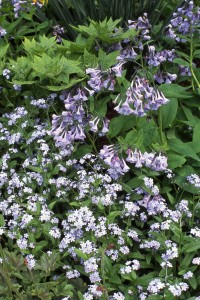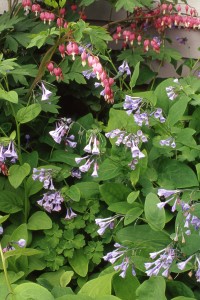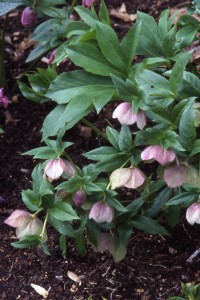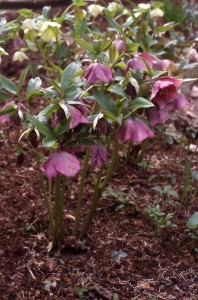Breathtaking Bluebells
April 3, 2009 by admin
Filed under Shade Gardening, Spring Bloomers, Spring Ephemerals
Virginia bluebells (Mertensia virginica) are nothing less than the royalty of spring ephemerals. Large, showy, and colorful, they put on one of the very best spectacles of any spring blooming plant, with all the rich costuming you’d expect in the court of a queen.

A May mêlée of Virginia bluebells and forget-me-nots
Virginia bluebells break ground very early in spring. Their tightly furled leaves look like tiny burgundy cabbages when they first emerge, but as they grow they quickly morph into medium green, fleshy oblongs that resemble the leafy green vegetable sorrel. Seemingly in no time they produce profuse clusters of dangling blue bell-shaped flowers on 18″ stems, blooming for several weeks in May. (They also come in a white-flowered form that is uncommon but possible to find.) Once flowering ceases, and almost before you have time to notice, they close up shop. Their leaves yellow rapidly, and the plants have gone completely dormant by mid June. They’ll spend the remainder of the year as inscrutable, seemingly dead but really just dormant roots nestled just below the soil surface. Incredibly, their entire aboveground life cycle is barely two months long.
The sheer rapidity of their growth and “demise” along with their large size and showiness make Virginia bluebells very border friendly. Their leaves do not need to hang around the garden for months to store enough energy to ensure flowering the following year. They put on their spectacular display and then vanish—a gardener’s dream!
Virginia bluebells are excellent interplanted with other blue-flowering plants such as perennial woodland phlox (Phlox divaricata). This phlox flowers just as the bluebells fade, so the segue from one to the other is seamless, and because the phlox spreads into a non-competitive groundcover, the bluebells will continue to arise through the mat of phlox foliage year after year. Biennial forget-me-not (Myosotis sylvatica) also makes a great companion, as shown in the photo above.
Virginia bluebells’ sky blue flowers are also an effective counterpoint to yellow daffodils. Gardeners with borders in both sun and shade can take best advantage of this artful duo, planting the sunny areas with clumps of daffodils and the shady ones with masses of bluebells. The result will be breathtaking!
Another natural companion is old-fashioned bleeding heart, whose brilliant pink or clean white flowers reach their peak simultaneously with those of Virginia bluebells, although the latter plant will go dormant months before the former. If you try this combination, use hostas, ferns or other late-emerging plants to fill in the areas occupied by the bluebells in May.

Bluebells and bleeding heart make a natural garden combination
Virginia bluebells spread readily by seed, moving outward from an original planting at a speed of a foot or two a year. In autumn, be careful working in the parts of your garden where bluebells are established, since it is so easy to dig into and accidentally destroy dormant roots at that time of year.
It’s not too late to have Virginia bluebells this year. Nurseries often stock them in April and early May since they’re one of the few plants that can be sold in full bloom at such a chilly time of year.
Sun/Shade needs: Half sun to moderately deep shade; full sun with adequate moisture
Hardiness: Zone 3
Size: 12-18″ tall; 8″ wide
Native status: Native to most of eastern North America, but not all of New England
Bloom times and other life cycle stats are accurate for northwest Connecticut. In milder areas all aspects of a plant’s life cycle may occur earlier in the year, and in colder areas, later.
March, 2010: Update! The good folks at GardenSMART took a shine to this article and reprinted it at their website. You’ll find this post (and many other interesting items) in the Articles section.
Spring Blooming Shade Plants: Hellebores
March 18, 2009 by admin
Filed under Perennials, Shade Gardening, Spring Bloomers
In a typical year, hellebores will be the first ornamental perennial to bloom in the Northeast. Although there are several species that can be grown in this region, especially in milder areas such as the coast and the lower Connecticut River Valley, one of the hardiest remains my favorite: Helleborus x hybridus (formerly and sometimes still known as Helleborus x orientalis).

Helleborus x hybridus
Here in northwest Connecticut, hellebores send up their flower buds first, in March, before their leaves unfurl. As the month goes on, these succulent and tender looking shoots grow taller and taller, until they finally open up around April 1 to reveal clusters of 2″-wide, pendant blossoms. The species H. x hybridus is quite variable, with a range of subtle flower colors including creamy white, apple green, pale pink and burgundy. Its flowers often have striking speckled markings and prominent yellow anthers that are showy for about a week until the stamens fall off.
At first, hellebore flowers look a bit undressed because the plant’s leaves don’t come along until a few weeks later. When they do make their appearance, however, they are exceptionally attractive—leathery, glossy, palmate (arranged like fingers around the palm of a hand) and semi-evergreen.

Hellebore flowers emerge before leaves
Everything about hellebores is long lasting. Instead of dropping off after 2-3 weeks, hellebore flowers slowly fade to a pale green or buff color in much the same way hydrangea flowers do. They look good (although subdued) right up to the point when the seeds mature and are dispersed, usually in the latter half of June. Deadhead them before that point unless you want seedlings the following spring. In most gardens, the leaves will remain disease free and unblemished all season long, and will still be looking good when the first snow flies.
Shade tolerance: High
Hardiness: Zone 5; other species may differ
Size: Medium sized, with a height and spread of 15-18″
Native status: non-native to any part of North America
Growing Tips
- Don’t cut back hellebore foliage in fall, even if you clean up the rest of your garden then. Why? Hellebores come up so early in the year, they are subject to damage from late frosts. These frosts won’t kill the plants, but they will kill the flower buds. As the plant’s shoots begin to emerge from the ground, last year’s leaves will provide some protection. After the new shoots have grown taller than last year’s leaves, you can groom them, cutting off the old foliage at ground level. Be careful not to accidentally cut off new growth—it’s easy to do. For a few more weeks after you groom them, it’s a good idea to keep some pine boughs or an equivalent handy to gently arrange over the new growth at night if a hard frost is in the forecast.
- Hellebores have to be several years old before they are mature enough to flower. A nursery plant in a 5-pint pot is probably only two years old, so don’t be surprised if it doesn’t flower its first (or even second) year in the ground. As long as the plant grows well and looks healthy, flowering should start when the plant is ready. A plant that fills a one-gallon pot should be old enough to flower its first spring after planting.
- H. x hybridus is often sold in a mix of undifferentiated colors. In other words, if the tag in the pot with your plant does not specify a flower color, but just says H. x hybridus, it could be any of the flower colors listed above. There’s no way to know which color you’ve got unless you buy the plant in bloom very early in the season and the plant is old enough to be blooming in the first place. In recent years, some growers have also offered hellebores in designated colors. I like the way the mixed colors look in the garden when hellebores are massed, but gardeners with color-theme gardens might prefer to purchase all of one kind.
- Hellebores have no special needs, but they don’t like excessive moisture. If put in exceedingly dank locations or planted in soils that drain poorly, rot of the crown may result.
- Hellebores self-sow moderately. Their seeds are large and heavy, so they don’t usually travel very far. If you don’t deadhead your plants before they drop their seeds, you’ll probably find a “skirt” of seedlings around their feet in spring. Move these to a nursery bed to mature or give them away to friends.
Bloom times and other life cycle stats are accurate for northwest Connecticut. In milder areas all aspects of a plant’s life cycle may occur earlier in the year, and in colder areas, later.

